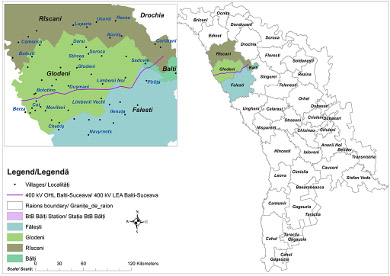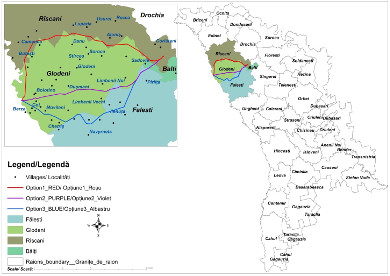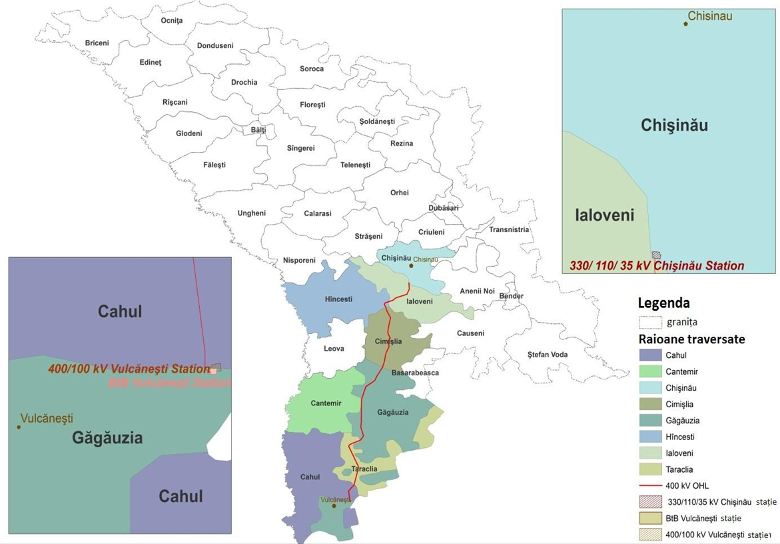|
Project Goals |
Asynchronous connection of Moldova's and Romania's electric grids is an important step towards integration into the European electricity market. This process will allow the Republic of Moldova to participate in the European electricity market through "ENTSO-E" (European Network of Transmission System Operators for Electricity).
|
|
Project Objective |
|
Part 1: Feasibility assessment and environmental, social, and economic impact evaluation (EIMS) for the first priority project (implemented and approved)
BtB Power Station in Vulcănești and the 400 kV Vulcănești-Chisinau Power Line
Part 2: Feasibility assessment and development plan for the next priority project (in progress)
BtB Power Station and 400 kV Bălți-Suceava Power Line (current project)
|
|
Client |
|
MOLDELECTRICA State Enterprise
|
|
Consulting Consortium |
-
ISPE – Institute for Energy Research and Design, Romania - Coordinator
-
ICPT "Energoproiect", Republic of Moldova
-
IVL – Institute for Environmental Research, Sweden
|
|
Project Duration and Category |
Project Category: “A”
Planning Stage: 8-10 months
-
Feasibility assessment and development plan for the second priority project (subject of this document)
Implementation Stage: 2.5 years
-
10-12 months – Procurement procedures, engineering and design, permits and approvals, land acquisition (expropriation)
-
18-20 months – Construction, including construction process organization, testing, and commissioning
Operation and maintenance stage: 30-40 years
Dismantling Stage: 3-8 months |
|
Expected Results |
• Initial and interim reports
• Technical and economic justification
• Financial and economic analysis
• Information dissemination package:
◦ Environmental and Social Impact Report (ESIR)
◦ Social and Environmental Impact Management and Monitoring Plan (SEI&MP)
◦ Non-Technical Summary (NTS)
◦ Stakeholder Engagement Plan - Final Version (SEP)
When determining funding sources, the project will transition from the planning phase to the implementation phase, including the preparation of design works, obtaining permits/licenses, construction and installation of equipment, commissioning, and operation. |
|
|
|
Key Analysis and Impact Minimization |
Project (Part 2) analyzes, from technical, economic, and social perspectives, the following components:
-
New 400 kV "Back to Back" substation and modifications at the existing 330/110 kV substation in Bălți
-
New 400 kV power transmission line (PTL) between Bălți and Suceava substations.
Three alternatives were considered for selecting the optimal route for the new PTL. Based on a multi-factor analysis, Alternative 2, the 400 kV Bălți-Suceava PTLroute, was chosen as optimal.
-
Technical parameters (e.g., PTL length, coexistence with other infrastructure such as roads, railroads, rivers, other PTLs and communication lines, pipes, etc., route accessibility, route complexity, investment costs, etc.)
-
Socio-economic factors (e.g., access to agricultural lands, deforestation, land ownership in areas intersected by local communities and productive agricultural areas, expropriation with relocation or compensation, temporary impacts on air quality (dust and particles), noise due to increased traffic intensity and volume during preparation and construction, etc.)
-
Environmental parameters (e.g., intersection of protected forest areas, rivers, and lakes, electromagnetic field impact, ecosystem, flora, and fauna impact, visual impact, etc.)
-
Cultural heritage (e.g., impact on monuments and historical buildings, intersection of archaeological sites, etc.)
The decision to select Alternative 2 (marked in purple) was aimed at minimizing potential consequences such as land impact, deforestation, cultural heritage impact, monuments, relocation or compensation, property losses, and changes to economic activity. |
|
Stakeholders |
|
-
Government officials and politicians
-
Regulatory bodies
-
Local and regional authorities
-
Project developers, investors, and financial institutions
-
Research institutes and academic institutions
-
Non-governmental organizations
-
Local population and citizens potentially affected by future construction and operation of the power line
-
Media
|
|
For further information |
|
Any comments or concerns can be directed to MOLDELECTRICA either verbally (by phone) or in writing (by mail or email) through the completion of a complaint form. The form will be available at town halls, schools, community centers, and other public places conveniently located for all stakeholders.
https://moldelectrica.md/ro/finances/mold_rom_project
Project Manager: Vyacheslav Zastavnetsky, Deputy General Director of SE Moldelectrica
[email protected]
Social and Environmental Issues: Nelly Melnicenco
[email protected], телефон 22 253396
Technical Issues: Octavian Ciobîrca [email protected]
|
|



